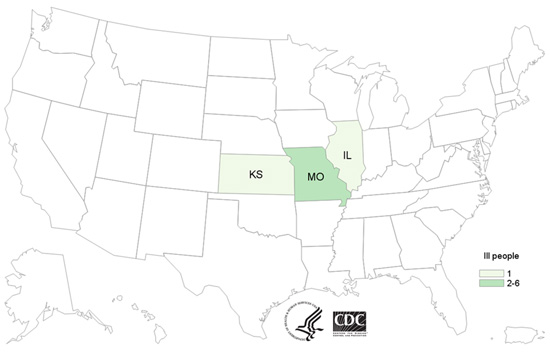2016 Salmonella Linked to Good Earth Egg Company Shell Eggs
Posted November 9, 2016 3:30 PM ET
This outbreak appears to be over, but it is a reminder to always follow food safety steps to handle and cook eggs safely to avoid foodborne illness from raw eggs.
- Read the Recall & Advice to Consumers, Restaurants, and Retailers >>
- This outbreak appears to be over, but it is a reminder to always follow food safety steps to handle and cook eggs safely to avoid foodborne illness from raw eggs.
- CDC, the Missouri Department of Health and Senior Services and Department of Agriculture, several states, and the U.S. Food and Drug Administration (FDA) investigated a multistate outbreak of Salmonella Oranienburg infections.
- Eight people infected with the outbreak strains of Salmonella Oranienburg were reported from three states.
- Two ill people were hospitalized, and no deaths were reported.
- Epidemiologic, laboratory, and traceback investigations identified shell eggs distributed by Good Earth Egg Company of Bonne Terre, Missouri as the likely source of this outbreak.
- On October 3, 2016, Good Earth Egg Company recalled all of its shell eggs because they have the potential to be contaminated with Salmonella.
- The recall includes all shell eggs produced by this company with sell by dates of 10/8/16 and earlier.
- The recalled eggs were distributed throughout the Midwest, including Missouri, Illinois and Kansas, to supermarkets, wholesalers, restaurants, institutions, and direct sales to customers.
- CDC recommends that consumers do not eat and restaurants and retailers do not serve or sell recalled shell eggs distributed by Good Earth Egg Company.
Introduction
CDC worked with public health and regulatory officials in Missouri, several other states, and the U.S. Food and Drug Administration (FDA) to investigate a multistate outbreak of Salmonella Oranienburg infections.
Public health investigators used the PulseNet system to identify illnesses that were part of this outbreak. PulseNet, coordinated by CDC, is the national subtyping network of public health and food regulatory agency laboratories. PulseNet performs DNA fingerprinting on Salmonella bacteria isolated from ill people by using techniques called pulsed-field gel electrophoresis (PFGE) and whole genome sequencing (WGS). CDC PulseNet manages a national database of these DNA fingerprints to identify possible outbreaks.
Eight people infected with the outbreak strain of Salmonella Oranienburg were reported from three states. A list of states and the number of cases in each can be found on the Case Count Map page.
Among people for whom information was available, illnesses started on dates ranging from April 23, 2016 to August 24, 2016. Ill people ranged in age from 1 year to 85, with a median age of 44. Sixty-three percent of ill people were female. Among seven people with available information, two (29%) were hospitalized. No deaths were reported.
Whole genome sequencing showed that isolates from ill people are closely related genetically to one another. This close genetic relationship means that people in this outbreak are more likely to share a common source of infection.
The strain of Salmonella Oranienburg in this outbreak is closely related genetically to a Salmonella Oranienburg strain from a 2015 outbreak linked to the Good Earth Egg Company. In the 2015 outbreak, 52 people infected with the outbreak strain were reported from six states. In response to the 2015 outbreak, Good Earth Egg Company recalled all of its shell eggs on January 9, 2016.
Investigation of the Outbreak
Epidemiologic, laboratory, and traceback investigations identified shell eggs distributed by Good Earth Egg Company of Bonne Terre, Missouri as the likely source of this outbreak.
In interviews, ill people answered questions about the foods they ate and other exposures in the week before they became ill. Of the six ill people who were interviewed, all six (100%) reported eating or possibly eating shell eggs in the week before illness started. Ill people reported eating eggs in restaurants as well as at home.
Federal, state, and local health and regulatory officials performed a traceback investigation from one restaurant location in Missouri where three ill people reported eating eggs. This investigation indicated that Good Earth Egg Company supplied eggs to that restaurant.
Missouri state and local health officials collected and tested shell eggs from the Missouri restaurant location and isolated the outbreak strain of Salmonella Oranienburg. Additionally, environmental samples taken at the Good Earth Egg Company processing facility isolated the outbreak strain of Salmonella Oranienburg. Whole genome sequencing showed that the isolates of Salmonella Oranienburg from eggs distributed by Good Earth Egg Company and from environmental samples collected in 2016 at Good Earth Egg Company were closely related genetically to isolates from ill people in this outbreak and from ill people and environmental samples in the 2015 outbreak. This close genetic relationship provided additional evidence that ill people in this outbreak and in the 2015 outbreak got sick from eating shell eggs distributed by Good Earth Egg Company.
On October 3, 2016, Good Earth Egg Company recalled all of its shell eggs because they have the potential to be contaminated with Salmonella. Recalled Good Earth Egg Company products were distributed throughout the Midwest, including Missouri, Illinois and Kansas.
This outbreak appears to be over, but it is a reminder to always follow food safety steps to handle and cook eggs safely to avoid foodborne illness from raw eggs.


